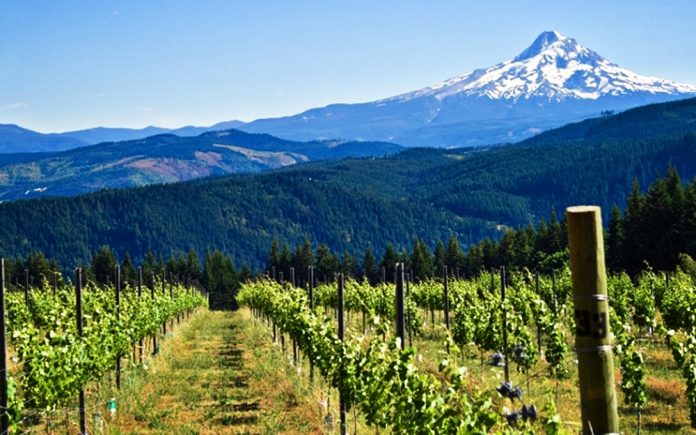
By Rick Riozza
So, when was the last time we checked on the wine country of Oregon and Washington?
Or, better stated, when was the last time we enjoyed some great stuff from our wine neighbors to the north?
We Californians are so spoiled with our own varied wine regions that we forget how marvelous the wines from the north can be. For certain we’ll find a recognizable Oregon Pinot Noir on the dinner table of our friends, or someone will bring over some Chateau Ste. Michelle wine that we like but have had on numerous occasions.
Most wine enthusiasts are quite aware of the wonderful Pinot Noir from Oregon; we cover the wines quite often as they are world class. And many think only of the Rieslings and easy Cabs from Washington. So I thought we’d re-visit the new goings on with the wine trade up there.
It’s been said that no single place grows every grape variety equally well. Moreover, grapes know nothing about imaginary lines like state borders. In the Pacific Northwest, there’s an interesting problem emerging: enterprising winemakers are reaching into each other’s state to tap great vineyard sources and craft compelling wines. Geographically speaking, the Columbia River, which serves as the state border between the two states, doesn’t stop vintners from considering wine property just over the river or over some politically drawn line.
Indeed, Walla Walla vintners cross over to Oregon quite often. A couple of years ago, some of the Wagner family had to readdress their wine labels when they claimed all Oregon fruit in the bottle but had some Washington stuff in the mix as well. But each state has their own alcohol laws. Interested in becoming a “wine lawyer”? Sounds like there will be plenty of work.
Anyway—cut to the chase, this week we’re talking about the explosion of Oregon Pinot Gris. Of course, it’s pronounced “peenoh-greee”. Yeah—that’s French for the “gray grape”. In Italian, you already know it as Pinot Grigio [Peenoh-GreeJoh]. Funny thing, I’ll hear some customers simply pronounce Pinot Gris as it looks in English: Pinot “GRISS”. And for a “soft” tasting grape, the hearty sounding word “GRISS” comes off a little rough. But I guess that’s just me.
Then again, sometimes I think the customers are having fun with the word—purposefully mispronouncing French words is often funny. But I guess that’s just me.
So as one would expect in the crazy world of wine, we come to find out that your favorite red grape, Pinot Noir, has the same DNA as Pinot Grigio/Gris. They are mutant clones of each other. Plant a Pinot Noir grape in Oregon and it kind of tastes like a Pinot planted in Burgundy; but plant a Pinot Gris in France however, it doesn’t come close to the flavor of an Oregon Pinot Gris or an Italian Pinot Grigio.
If you can find distinguishing differences between classic “Grigio” and “Gris”, it seems as though you’d find three main types: Minerally & Dry; Fruity & Dry; and, Fruity & Sweet.
Everyone has tasted the classic Pinot Grigio from Italy. Generally it’s zippy and lean (those from Friuli—can be more rounder with light fruit). But the Pinot Gris from Oregon can be explosively floral and luscious yet crisp, with kiwi, lemon, nectarine, and pear flavors. Oregon winemakers early on used the French “Pinot Gris” to describe a more fruit-driven style as compared to the Italian Pinot Grigio term. So, we now can Expect flavors of lemon, yellow apple, and white peach with a slightly richer texture.
By the late 1990s, Pinot Gris quietly became the number one white grape grown in Oregon. And now twenty years later, everyone knows it.
Currently, we like 2020 Elk Grove Estate Pinot Gris ($19) a medium bodied, deeply fruited wine that packs in pink grapefruit, lemon curd, tangerine and papaya flavors along with some tangy acidity.
And a wine that can be found at most supermarkets is the 2020 A to Z Pinot Gris ($16). It’s loaded with flavors of freshly cut pears showing delicious vibrancy: clean and fruity, with balanced acidity and a hint of minerality. A fun wine for all meals.
Okay—on to Washington. No new news here: Walla Walla Valley Syrah continues to be world class—indeed, it is one of the world’s best that meet up with France’s Northern Rhone wines.
In 1997, Frenchman Christophe Baron planted the first in a series of vineyards on an ancient cobblestone riverbed in the Walla Walla Valley at the southeast region of Washington… At Cayuse Vineyards, Baron forever changed Syrah’s story in the state, putting a focus on single-vineyard, terroir-driven wines. Two years later, K Vintners from the popular “rockstar” Winemaker Charles Smith had its first offerings.
Many of the best Syrahs are grown in the Rocks District of Milton-Freewater, a subappellation of the Walla Walla Valley AVA, but great stuff is grown throughout the state.
For the price, one of the best Syrahs out at $40, is the 2017 K Syrah Wahule Slope, The Deal Sundance Vineyard. It offers classic aromas of blackberry, black peppercorn, and savory dried herbs. Medium to full-bodied, complex, rich and powerful, we find flavors of sweet tobacco, berries, black raspberry, leafy herbs, dried meat and spice. There’s a lively acidity as well. Chocolate, spice, and ripe-fruit flavors lead the finish. The wine concludes with a long finish and a dusty sensation of bitter dark chocolate and blackberry skin. What’s not to love here!! Cheers!










































